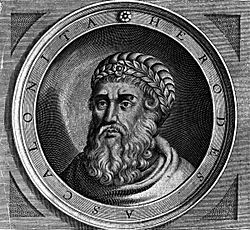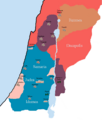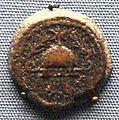Herod the Great facts for kids
Herod I (c.73/75–4 BC), also known as Herod the Great, was the King of Judea from 37 to 4 BC. At the time Judea was a client state of Rome. During his 33 year reign, Herod was an excellent administrator.
Contents
Rise to power
Herod was born about 73–75 BC. He was the son of Antipater the Idumaean and his wife Cyprus, the daughter of an Arabian sheik. Both Herod's grandfather and his father were political officials in Judea. Both had close ties to the Romans. Herod rose to power largely through his father's good relations with the Roman general and dictator Julius Caesar, who entrusted Antipater with the public affairs of Judea. In 47 BC Antipater made his oldest son, Phasael, the governor of Jerusalem. He made Herod governor of Galilee. As governor, Herod won favor with the Romans by his dealing with hostile revolts. At the same time his actions were censured by the Great Sanhedrin.
King of Judea
Herod was friends with Octavian and Mark Antony who in 40 BC had the Roman Senate designate Herod as the next king of Judea. Herod traveled to the Temple of Jupiter to give thanks to the gods of Rome. When the king of Judea was killed in 37 BC, Herod became the de facto king.
During Herod's early years as king, Mark Antony's relationship with Cleopatra allowed the Egyptian queen to keep taking small parts of Herod's kingdom. When Octavian defeated Antony and Cleopatra at the Battle of Actium in 31 BC, Herod made a new alliance with Octavian. He gained a reputation for his harsh taxes but was able to keep the peace in the region. He sent expensive gifts to Rome but did not have to pay tribute. By 30 BC, he had regained all the territory Cleopatra and the Hasmoneans had taken. He expanded his rule into northern Galilee and resettled several areas. By giving extravagant gifts to Athens and supporting the Olympic Games he increased the status of Judea in the Mediterranean world.
Achievements
Herod saw himself as the perfect example of a refined king even if Bible writers saw him as a tyrant. He became completely involved in Greco-Roman history, culture and philosophy. At the same time he began neglecting the affairs of state and the study of Halakha (Jewish law). He needed the consent of the Pharisees in order to rule so he kept trying to gain their approval in a number of ways. He never won them over completely. When he built the Caesarea Maritima (22–10 BC) in honor of his patron Caesar Augustus, the pagan symbols decorating his cities upset the Jewish leaders. He organized fights between gladiators every five years, which further upset the Jewish leaders. In 20 BC, Herod turned his attention to building the Second Temple, also called Herod's Temple. While Herod wanted the temple to be the crowning monument to the Jewish faith, he used Greek architects. He allowed moneylenders to operate in the temple courtyard which angered many Jews.
His greatest religious scandal was digging up King David's Tomb to find the treasure it was rumored to contain. He had spent great sums of money on his other projects and thought that by secretly robbing the tomb he could profit from any treasure he found there. But on opening the tomb, there was no treasure.
Herod undertook many colossal building projects. Around 19 BCE, he began a massive expansion project on the Temple Mount. In addition to fully rebuilding and enlarging the Second Jewish Temple, he artificially expanded the platform on which it stood, doubling it in size. In addition, Herod also used the latest technology in hydraulic cement and underwater construction to build the harbor at Caesarea Maritima. While Herod's zeal for building transformed Judea, his motives were not selfless. Although he built fortresses (Masada, Herodium, Alexandrium, Hyrcania, and Machaerus) in which he and his family could take refuge in case of insurrection, these vast projects were also intended to gain the support of the Jews and improve his reputation as a leader. Herod also built Sebaste and other pagan cities because he wanted to appeal to the country's substantial pagan population. In order to fund these projects, Herod utilized a Hasmonean taxation system that heavily burdened the Judean people. Nevertheless, these enterprises brought employment and opportunities for the people's provision. In some instances, Herod took it upon himself to provide for his people in times of need, such as during a severe famine that occurred in 25 BCE.
Death
Herod died in Jericho, after an excruciatingly painful, putrefying illness of uncertain cause, known to posterity as "Herod's Evil".
Successors
Augustus respected the terms of Herod's will, which stipulated the division of Herod's kingdom among three of his sons. Augustus recognised Herod's son Herod Archelaus as ethnarch of Judea, Samaria, and Idumea from c. 4 B.C. – c. 6 C.E. Augustus then judged Archelaus incompetent to rule, removed him from power, and combined the provinces of Samaria, Judea proper, and Idumea into Iudaea province. This enlarged province was ruled by a prefect until the year 41 CE. As to Herod's other sons, Herod Antipas was tetrarch of Galilee and Peraea from Herod's death to 39 CE when he was deposed and exiled; Philip became tetrarch of territories north and east of the Jordan, namely Iturea, Trachonitis, Batanea, Gaulanitis, Auranitis and Paneas, and ruled until his death in 34 CE.
Herod's tomb
The location of Herod's tomb is documented by Josephus, who writes, "And the body was carried two hundred furlongs, to Herodium, where he had given order to be buried." Professor Ehud Netzer, an archaeologist from the Hebrew University, read the writings of Josephus and focused his search on the vicinity of the pool and its surroundings. An article in the New York Times states,
Lower Herodium consists of the remains of a large palace, a race track, service quarters, and a monumental building whose function is still a mystery. Perhaps, says Ehud Netzer, who excavated the site, it is Herod's mausoleum. Next to it is a pool, almost twice as large as modern Olympic-size pools.
On May 7, 2007, an Israeli team of archaeologists of Hebrew University, led by Netzer, announced they had discovered the tomb. The site is located at the exact location given by Josephus, atop tunnels and water pools, at a flattened desert site, halfway up the hill to Herodium, 12 kilometers (7.5 mi) south of Jerusalem. The tomb contained a broken sarcophagus but no remains of a body.
Not all scholars agree with Netzer: in an article for the Palestine Exploration Quarterly, archaeologist David Jacobson (University of Oxford) wrote that "these finds are not conclusive on their own and they also raise new questions." In October 2013, archaeologists Joseph Patrich and Benjamin Arubas also challenged the identification of the tomb as that of Herod. According to Patrich and Arubas, the tomb is too modest to be Herod's and has several unlikely features. Roi Porat, who replaced Netzer as excavation leader after the latter's death, stood by the identification.
The Israel Nature and Parks Authority and the Gush Etzion Regional Council intend to recreate the tomb out of a light plastic material, a proposal that has received strong criticism from major Israeli archeologists.
Opinions of his reign
According to contemporary historians, Herod the Great "is perhaps the only figure in ancient Jewish history who has been loathed equally by Jewish and Christian posterity", depicted both by Jews and Christians as a tyrant and bloodthirsty ruler.
Herod's religious policies gained a mixed response from the Jewish populace. Although Herod considered himself king of the Jews, he let it be known that he also represented the non-Jews living in Judea, building temples for other religions outside of the Jewish areas of his kingdom. However, Herod was also praised for his work, being considered the greatest builder in Jewish history, and one who "knew his place and followed [the] rules." In fact, what is left of his building ventures are now popular tourist attractions in the Middle East, which many have come to cherish as both a historical and religious area.
Images for kids
-
Distinctive Herodian masonry at the Western Wall in Jerusalem
-
The Division of Herod's Kingdom: Territory under Herod Archelaus Territory under Herod Antipas Territory under Philip the Tetrarch Jamnia under Salome I.
-
Herod's sarcophagus, displayed at the Israel Museum
See also
 In Spanish: Herodes I el Grande para niños
In Spanish: Herodes I el Grande para niños








